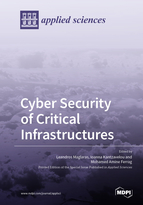Cyber Security of Critical Infrastructures
A special issue of Applied Sciences (ISSN 2076-3417). This special issue belongs to the section "Computing and Artificial Intelligence".
Deadline for manuscript submissions: closed (20 August 2021) | Viewed by 70032
Special Issue Editors
Interests: cyber security; privacy preservation; risk management; routing protocols; vehicular networks; social network analysis; power electronics
Special Issues, Collections and Topics in MDPI journals
Interests: IT security; cybersecurity; intrusion detection in information and communication systems; attacker profiling; attack modeling; game theory
Special Issues, Collections and Topics in MDPI journals
Interests: agricultural internet of things; wireless network security; network coding security; applied cryptography
Special Issues, Collections and Topics in MDPI journals
Special Issue Information
Critical infrastructures are vital assets for public safety, economic welfare, and the national security of countries. Vulnerabilities of critical infrastructures have increased with the widespread use of information technologies. As Critical National Infrastructures are becoming more vulnerable to cyberattacks, their protection becomes a significant issue for any organization as well as nation. The risks to continued operations from failing to upgrade aging infrastructure or not meeting mandated regulatory regimes are considered higher given the demonstrable impact of such circumstances.
Due to the rapid increase of sophisticated cyber threats targeting critical infrastructures with significant destructive effects, the cyber security of critical infrastructures has become an agenda item for academics, practitioners, and policy makers. A holistic view which covers technical, policy, human, and behavioral aspects is essential to handle cyber security of critical infrastructures effectively. Moreover, the ability to attribute crimes to criminals is a vital element of avoiding impunity in cyberspace.
In this Special Issue, both research and practical aspects of cyber security considerations in critical infrastructures are of interest. Aligned with the interdisciplinary nature of cyber security, authors from academia, government, and industry are welcome to contribute.
We seek original and high-quality submissions on, but not limited to, one or more of the following topics:
- Security of the smart grid;
- Security of supervisory control and data acquisition (SCADA) systems;
- Cyber security of complex and distributed critical infrastructures;
- Cyber security of industrial control systems;
- Cyber security modeling and simulation;
- Cyber threat modeling and analysis;
- Safety-security interactions;
- Cyber security engineering;
- Behavioral modeling;
- Network security and protocols;
- Security, privacy, and legal issues of big data and the Internet of Things;
- Cyber threat intelligence;
- Situational awareness;
- Attack modeling, prevention, mitigation, and defense;
- Cyberphysical systems security approaches and algorithms;
- Critical infrastructure security policies, standards and regulations;
- Vulnerability and risk assessment methodologies for distributed critical infrastructures;
- Risk management and cyber insurance;
- Simulation and test beds for the security evaluation of critical infrastructures;
- Resiliency and security of cyber systems;
- Cyber security and privacy policy;
- Hardware security solutions;
- Incident response;
- Encryption, authentication, availability assurance;
- Human awareness and training;
- Intrusion detection;
- Trust and privacy;
- Secure communication protocols;
- Malware analysis;
- Attribution of cyberattacks;
- Cyber warfare, peacekeeping;
- Hybrid war…
Asst. Prof. Ioanna Kantzavelou
Dr. Mohamed Amine Ferrag
Guest Editors
Manuscript Submission Information
Manuscripts should be submitted online at www.mdpi.com by registering and logging in to this website. Once you are registered, click here to go to the submission form. Manuscripts can be submitted until the deadline. All submissions that pass pre-check are peer-reviewed. Accepted papers will be published continuously in the journal (as soon as accepted) and will be listed together on the special issue website. Research articles, review articles as well as short communications are invited. For planned papers, a title and short abstract (about 100 words) can be sent to the Editorial Office for announcement on this website.
Submitted manuscripts should not have been published previously, nor be under consideration for publication elsewhere (except conference proceedings papers). All manuscripts are thoroughly refereed through a single-blind peer-review process. A guide for authors and other relevant information for submission of manuscripts is available on the Instructions for Authors page. Applied Sciences is an international peer-reviewed open access semimonthly journal published by MDPI.
Please visit the Instructions for Authors page before submitting a manuscript. The Article Processing Charge (APC) for publication in this open access journal is 2400 CHF (Swiss Francs). Submitted papers should be well formatted and use good English. Authors may use MDPI's English editing service prior to publication or during author revisions.








